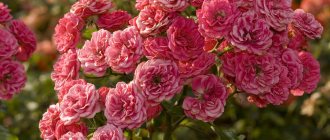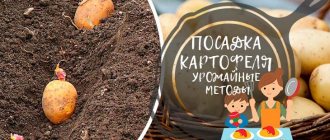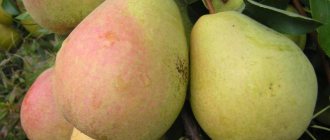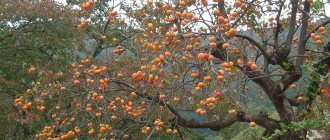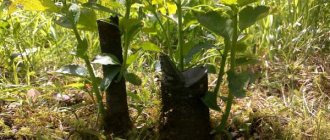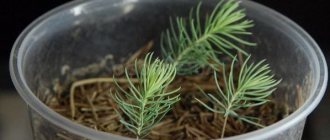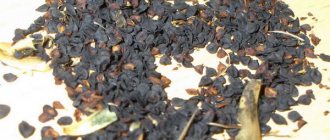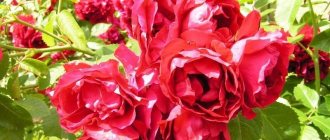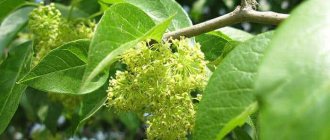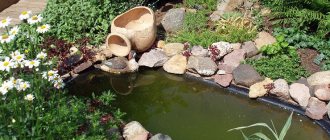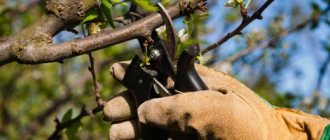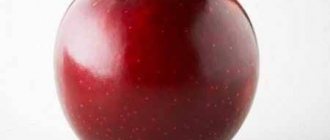Description of Podbelskaya cherry
The variety is quite old; it was bred back in the 19th century in Germany by breeder Karl Koch, who crossed the Lotova cherry and the Griot Ostheim cherry. Testing of the variety continued for quite a long time, and in Russia it was zoned in 1947 for the warm North Caucasus region.
The variety is recommended for cultivation in the North Caucasus and other southern regions
Podbelskaya is a fairly tall tree with a rounded dense crown, prone to flattening with age. The branches and shoots of the tree are covered with gray-brown smooth bark and longitudinal cracks, the shoots are directed upward and slightly bend when fruit appears. The leaves of the cherry are large, up to 6 cm wide and 12 cm long, broadly oval, green in color, matte and slightly fleecy.
Podbelskaya blooms in small inflorescences consisting of 3-4 white flowers with rounded petals up to 3 cm in diameter. The fruits are held on small, short petioles.
Important! According to the description of the variety, Podbelskaya cherry produces shoots at the roots, and quite actively. This is both an advantage and a disadvantage of the variety; the shoots allow you to easily propagate cherries, but at the same time you have to make sure that they do not grow too much.
The height and diameter of the crown of the Podbelskaya cherry
The height of an adult fruit tree is on average 5 m. The crown is dense, widely leafy, and can reach 2 m in diameter, especially in an adult tree with significant growth.
The tree can grow quite high - up to 5 m
Description of fruits
From the photo of the Podbelskaya cherry variety and from the description of the variety, it can be established that the plant bears large flat-round berries, weighing up to 6 g. The color of the fruits is burgundy, almost black, the pulp of the berries is fibrous, but at the same time very juicy, dark red in color and sourish-sweet taste. The pulp separates well from the cherry pit. The taste of the fruit is considered dessert - the tasting score ranges from 4.8 to 5 points, for which gardeners especially value the variety.
Since Podbelskaya is a heat-loving variety and feels very good in the sun, its fruits do not bake under the sun’s rays and remain juicy. Ripening occurs unevenly and is extended over time, but ripe berries stay on the petioles for quite a long time, so you don’t have to rush into picking.
Podbelskaya has a very sweet, dessert taste.
Podbelskaya cherry pollinators
Podbelskaya belongs to the early flowering varieties and usually blooms in early May if it is grown in a warm region. Gardeners need to take into account that the variety is self-sterile - without pollinators, fruits cannot be expected.
The English Rannyaya, Lotovaya, Anadolskaya, and Griot Ostgeimsky varieties are well suited for pollination of Podbelskaya. All of these cherries bloom at similar times, and planting them side by side in the garden area will be very beneficial.
Cherry variety ripening period, yield indicators
The tree begins to bear fruit 3 years after planting the grafted seedling. Cherry Podbelskaya is a mid-early variety.
Peak fruiting occurs in the third decade of June. Depending on the region of growth, the ripening period will differ. For example, in the Lower Volga region the harvest can be harvested in the first ten days of June, and in the North Caucasus the berries will begin to ripen on the 17th of the same month.
The plant boasts high yields that increase over the years. From a young tree you can collect up to 14 kg of fruit. After 10-15 years, you can get at least 30 kg of berries from one plant.
Fruiting culture
Main characteristics
Before planting Podbelskaya on a suburban area, you need to study its main features. This will help you decide whether it is worth the effort to grow the tree.
Drought resistance, frost resistance
Podbelskaya tolerates short-term dry periods well. A lack of water for this sun-loving tree is much better than an excess of moisture; the plant reacts sharply negatively to waterlogging.
The variety practically does not tolerate frost even in the middle zone
But Podbelskaya is very sensitive to frost. It does not tolerate even mild frosts well, so growing it in the Moscow region and the middle zone is associated with certain difficulties. The plant feels best in the North Caucasus and Crimea, where winter temperatures remain mild.
Productivity
According to the ripening period, the Podbelskaya cherry variety belongs to the early-medium category. In Crimea and the Caucasus, fruits can be harvested already in mid-June, in the middle zone - in early July. For the first time, Podbelskaya begins to bear fruit 4 years after planting in the ground.
Yield indicators depend primarily on the presence of pollinators. Since the variety cannot bear fruit on its own, high-quality pollination is very important for a good harvest. Also, the number of fruits depends on growing conditions, watering and whether some of the flower buds died during the spring frosts. In good circumstances, Podbelskaya cherry is capable of producing 30-40 kg of berries from one tree, sometimes up to 50-60 kg.
Attention! The yield of Podbelskaya depends, among other things, on age - young trees do not bear fruit very abundantly, the variety reaches its maximum values by 12-15 years.
The variety reaches its maximum yield at 12-15 years of age.
The transportability of cherry fruits of this variety is normal, average; the cherries are suitable for storage, but for a limited period. Podbelskaya has a universal use - the fruits are suitable for fresh consumption, for preservation for the winter, for making juices and compotes.
Advantages and disadvantages
Having studied the features of Podbelskaya, we can highlight several main advantages of the variety:
- dessert taste of the fruit, deserving the highest tasting rating;
- good yield;
- the versatility of fruits and their suitability for transportation for sale;
- relative resistance to most fungal diseases.
At the same time, Podbelskaya has its own shortcomings. The main one can be considered low frost resistance. Cherry feels good in the southern regions, but in the middle zone it can freeze, and growing it in Siberia does not make sense at all - the tree will die from frost. Another disadvantage of the variety is its self-sterility; without pollinators, Podbelskaya will not bear berries at all.
Harvest and storage
A clear day is chosen to harvest cherries. Dry berries are easier to pick and last longer. If you plan to transport cherries, then remove them 2-3 days before they are completely ripe. This should not be done earlier, since berries that are too unripe will not ripen outside the tree and will be hard and sour. For transportation, cherries are harvested with the stalk intact. The petioles do not need to be saved for consumption and processing.
If the size of the plot allows you to place such a large cherry tree as “Podbelskaya” on it, then you can do it without hesitation. With such volumes of harvests, there may not be a need to plant other cherry trees. In addition, Podbelskaya cherries are long-lived and can produce crops for 25 years or more.
How to plant Podbelskaya cherry
Gardeners who decide to grow cherries need to study Podbelskaya’s requirements for planting and care. Growing the variety is not particularly difficult, provided that the tree grows in a warm climate.
The tree should be planted in a sunny area.
Recommended timing
Both in the middle zone and in the south, it is recommended to plant Podbelskaya in the spring - in April, after the snow has melted and the soil has warmed up. Since cold weather is very dangerous for the variety, autumn planting of cherries is not practiced; usually it does not have time to take root before the onset of winter.
Site selection and soil preparation
It is necessary to plant a tree in a well-lit place - Podbelskaya loves the sun and does not tolerate its deficiency. It is best to choose a place on a hill; it is unacceptable to plant cherries near groundwater, in which case the soil will always be swampy and the tree will die.
Before planting, you need to dig a deep hole about 50 cm deep and wide. The extracted soil must be mixed with humus, add 1 kg of wood ash, 20 g of potassium chloride and 30 g of superphosphate.
Advice! If the soil on the site is clayey and too damp, you can add a bucket of sand to the soil before planting, which will ensure soil drainage.
Landing algorithm
The procedure for planting cherries looks very simple:
- The prepared mixture of soil, humus and fertilizers is poured halfway into the hole.
- The seedling, previously soaked for a couple of hours in water, is lowered into the hole and covered with earth to the surface of the ground.
- Immediately after planting, pour 2 buckets of water under the trunk and mulch the soil with sawdust or compost.
Before planting, drainage is organized for the seedling and fertilizing is applied to the soil.
When planting cherries, the root collar should be at ground level; it cannot be deepened into the ground.
History of selection and region of breeding
The variety was bred at the All-Russian Research Institute of Horticulture named after I.V. Michurin" (VNIIS).
Reference. VNIIS is a technological organization engaged in the study of scientific areas of horticulture.
Dessertnaya Morozova, Morozovka and Ural Rubinovaya were also born at this institute.
Main focus: variety study of fruit trees and selection of new plant forms, disease resistance and ecology, cultivation and propagation of cuttings for planting, mechanization, technological methods for cultivating mature trees, proper storage of fruits.
The institute uses modeling and production of environmentally friendly products. When studying varieties, processes are automated. The organization implements innovative projects in various directions.
The university's developments have gained wide popularity among professionals and amateur gardeners.
Latin name: Cerasus. Author of the variety: T.V. Morozova.
The tree was obtained in 1990 from cherry pits of the Vladimirskaya variety. At the growth stage, the seed was treated with a solution of the mutagen EC.
It takes root well in the central and southern parts of Russia, Ukraine and Belarus.
Bred specifically for the Black Earth region. Distributed in Michurinsk, Voronezh, Rostov-on-Don, Pavlovsk.
Features of care
Caring for Podbelskaya cherries is quite simple. During the growing process, you need to adhere to the basic rules of watering, pruning and fertilizing.
Watering and fertilizing schedule
You need to water the tree with great care - too much water can cause the fruits to crack and begin to rot. It is recommended to moisten the soil under the cherry trunk only during periods of severe drought during flowering, ovary formation and fruiting.
As for fertilizers, for the first time mineral fertilizing is applied directly at planting. After this, Podbelskaya does not need to be fertilized at all for 2-3 years. Subsequently, cherries can be fed with potassium and phosphorus during fruiting and nitrogen during flowering.
Trimming
It is recommended to prune cherries annually for sanitary purposes and to eliminate root growth. Most pruning is carried out in early spring, removing shoots and broken, dried branches.
In the fall, the tree is inspected again and, if necessary, dead shoots are cut off again, and the ground around the trunk is thoroughly cleaned of plant debris.
Every autumn the tree needs to be pruned and shoots removed from the roots.
Preparing for winter
Podbelskaya needs especially careful shelter for the winter, since it does not tolerate cold weather. With the onset of autumn, the area is cleared of fallen leaves and dry branches, and the tree trunk is whitened to prevent cracking of the bark and attacks by pests.
In winter, the soil under the cherry tree trunk must be mulched with a dense layer of sawdust or compost. First, 20 liters of water are spilled on the ground. Young cherries should also be wrapped in burlap or cardboard to prevent the trunk from freezing.
Crown formation
Immediately after planting, the trunk is shortened to a height of 60–65 cm. In the future, taking into account the intensive growth of the Podbelskaya cherry and the tendency to thicken the crown, they try to give it a sparsely tiered shape.
In the fourth or fifth year, the crown is limited to a height of 3.5-4 m from the ground, removing part of the central conductor above the last skeletal branch. If this is not done, the tree will reach a height of more than five meters, which will lead to difficulties in caring for and harvesting.
In vigorous trees, a sparsely tiered crown is formed, which ensures the strength of the skeletal branches and good illumination
For trees older than five to six years, pruning comes down to maintaining shape and removing weak, diseased, broken, crossing, rubbing, and growing branches inside the crown. But the difficulties of care are compensated by the abundance and quality of the berry harvest.
Video: cherry pruning
Diseases and pests
Podbelskaya cherry demonstrates good resistance to coccomycosis, chlorosis and other fungal diseases - this is one of the advantages of the variety. However, the tree can be affected by monilial burn, which is dangerous for cherries, and suffers from common insect pests - aphids, cherry flies, sawflies.
To prevent and treat diseases, it is recommended to preventively treat the tree in the spring with Bordeaux mixture and azophos. It is also necessary to regularly dig up the soil at the roots of the cherry tree, whiten its trunk from time to time and treat all cracks and wounds on the trunk and shoots with copper sulfate.
Pros and cons of the variety
The advantages of this beautiful tree include a relatively high degree of resistance to various diseases, in particular fungal ones. Cherries also please their owners with good productivity and ideal taste qualities of fruits that have dessert and technical purposes. In the southern regions, this fruit tree grows well and produces a large harvest, while in the northern regions it can suffer from frost and burns, and annual tree shoots and generative buds may freeze.
By nature, Podbelskaya cherry is a cherry-cherry hybrid that resembles a simple cherry. The variety also has an average degree of resistance to hot and dry weather. Ripe fruits stick quite well to the tree. Ripening time: end of June – beginning of July. The disadvantages include the large size of the fruit tree, as they can somewhat complicate the procedure for caring for it, ripening the fruits and harvesting.
Landing
The best time to plant cherries is spring. The location is selected in advance, taking into account the degree of groundwater and the height of the site.
If it is low-lying, melt water may accumulate and the buds may freeze. To prevent such problems, an earthen dam is built in the selected location, and only after that young trees are planted.
For planting plants, a groove with a diameter of 50 cm is provided. If the soil is clayey, then a bucket of sand is added to the extracted soil. This mixture is then enriched with fertilizers such as wood ash (1 kg), humus, potassium chloride (20 g) and superphosphate (30 g).
The seedling is lowered into the groove, making sure that the root collar is flush with the ground.
The roots are covered with the prepared soil mixture, watered with at least 2 buckets of water and mulched.
